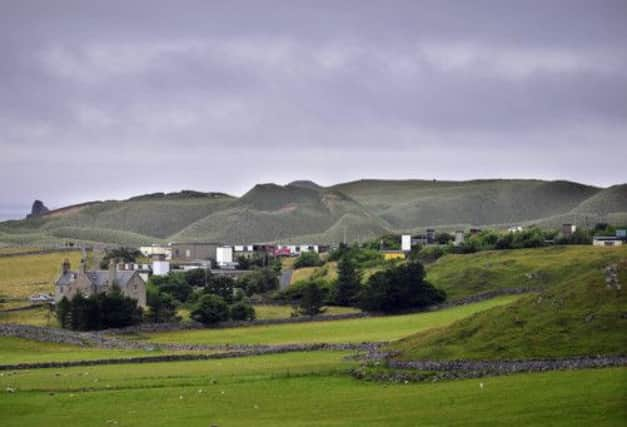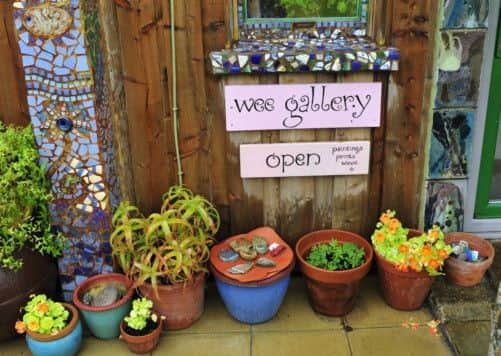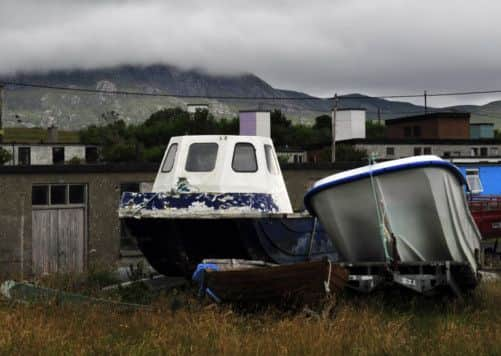Back of beyond: Balnakeil is far out


GO north. Follow that magnetic arrow six hours out of the Central Belt, far from the crowd of maddies, and carry on until you almost run out of land; then, at Durness, take a left, crest the brow of a rise, and you’re there – Balnakeil Craft Village, the most north-westerly community in Britain, laid out below you in all its turreted whitewashed strangeness. This is what you have come to see.
“As you come over the top coast road,” says Anita Wilson, one of around 40 residents, recalling the first time she ever saw her future home, “there’s nothing, nothing, nothing, nothing, nothing, nothing. It was November, and although it was beautiful there was still nothing there. Then you come round and you hit Ceannabeinne beach and Durness and Balnakeil, and it either really appeals to you, or you think, ‘I’ll never come here again in my life.’ Well, I just kept coming back. I’d always been around artists and musicians, and I didn’t have a nine-to-five attitude, so it just seemed like an awesome sort of place. It’s a more natural way of being.”
Advertisement
Hide AdAdvertisement
Hide AdBalnakeil Craft Village is 50 years old this year, probably. None who live there would quite swear to the anniversary, though neither would they deny it entirely. Out on the frayed edge of mainland Britain is a place where notions of time, too, have become tattered. No one seems able to remember the exact date of anything. Changing seasons, tides, the bloom of the wild poppies, the boom of the bombing exercises at Cape Wrath which take place each February and September – these are the temporal markers that count around here.


The “village” is like no village you will have ever seen; a cluster of around 30 bunker-like concrete buildings, single-story, flat-roofed, each with a large rectangular water-tower pointing accusingly at an overcast sky. Some are decorated with fishing buoys, artfully hung, and bright murals of flowers and sunbursts, but there is no denying the utilitarian shape of the homes themselves. They are blunt, brutalist, built in 1954 by the Ministry of Defence to house and cater for the staff of a planned military radar station which was being constructed on the nearby promontory, Faraid Head. These were barracks, mess rooms, a medical bay, a canteen. But then something happened. Local legend has it that the Russians shaved a couple of minutes off the time it would take for a nuclear missile to travel to the UK, meaning that any early warnings from Sutherland would not be quite early enough. The station became obsolete, and in the late 1950s, the buildings at Balnakeil were abandoned to the locals and the elements. Windows and fittings were broken, birds nested, and the salty wind scoured each breeze-block shell.
“Oh, it was an eyesore,” says Hugh Powell, an 84-year-old sculptor who lives, with his wife Molly, in the old manse next to the village. “It was getting smashed up and people were stealing the lead. Nobody knew what to do with it.”
Powell, in 1963, was head of industrial design at Leeds College of Art. At Easter, he drove up to Sutherland, for the first time, in a Volkswagen caravanette, carrying a load of drainpipes for a friend’s septic tank. Unloading these at the side of Loch Laxford, a little boat pulled up alongside, containing within it two worthies from Sutherland County Council. They were on their way to Balnakeil to discuss what could be done to prevent it from falling into further ruin. Powell, who knew that many of his students would love to work in a place like this, suggested that it be converted into a community for artists and crafts-people.
And that was that. Powell bought the manse; the money was used by the council to purchase the rest of the buildings from the MoD, and adverts were placed in the newspapers calling for tenants. Rent was set at £5 a year, for which you got your freezing concrete bunker, without electricity or running water, and found yourself living in what is, arguably, the most wondrous landscape in the whole of these isles. This was known as The Far North Project. It drew dreamers, wild-schemers, the unorthodox and idealistic. The first person to move in was Hector Riddell, a silversmith from Turriff, followed in short order by a worm-farmer.


“When we first came there were just three or four others and the buildings were totally vandalised,” recalls Lotte Glob, a Danish artist who now lives nearby in a croft overlooking Loch Eriboll. She and her husband, Dave Illingworth, were among the early settlers. “We came on July 24, 1968, at three in the morning, with two babies, a dog, a small-electric kiln, a potters wheel, a ton of clay and five pounds in our pocket. There was a huge military exercise going on, with helicopters flying overhead. We had a lot of choice of buildings because so many were empty. Windows were broken, doors were broken, the toilet was ripped out and you could look straight into the sewer. There was no power. All the copper pipe was pulled out. So we got the building at the top which was the old hospital. We found one room with a door and a window where we settled down with the kids. They were two-and-a-half and six months old. We didn’t have electrics for three months and I had to wash nappies in the stream. It was tough, but I was only 24, so.”
You’ve got to love that “so”. It speaks to a certain devil-may-care, last-roll-of-the-fluffy-dice attitude among those who came to Balnakeil then, and to an extent among those who still come today. It takes just ten minutes to walk around the village, which is picturesque in a rough, bohemian sort of way. Early in the day, you see more cats than people. A line of bright washing is strung between two drainpipes, a wagtail perches on a rusty mangle, the wind howls like God blowing across the neck of a bottle.
It is the height of summer yet the weather is poor. The oystercatchers have the beach to themselves. A woman hanging out clothes explains that up here every item, even unto the humblest sock, requires several pegs to hold it in place. Most of the craft village is, these days, residential, with interior decor ranging from chintzy suburban to shabby freak-pad. You never quite know whether you are walking into the set of Abigail’s Party or Withnail And I. There are, however, still a number of businesses here, among them a bakery, a busy boatyard and the most remote bookshop in mainland Britain. You can buy chocolates, paintings and crafty knick-knacks from the people who made them by hand. You can get your trumpet fixed. There is even a masonic lodge, with carved square and compasses on the door, in the old helicopter fuel store; odd, one might think, but then where better for freemasons to practise their craft than in a craft village?
Advertisement
Hide AdAdvertisement
Hide AdArguably, though, the most precious commodity in Balnakeil are the people themselves. You get all sorts and then some.
Philipp Tanzer, 35, has moved from Dresden to become the village’s newest resident. He plans to open a hairdressing salon and massage parlour. A one-time holder of the title German Mr Leather, he has had notable success as an actor in gay pornographic films. His annus mirabilis, 2009, saw him win best duo sex-scene, best three-way sex scene and best actor at the Grabby Awards. He performs under the name Logan McCree, a homage to his love for Scotland, his love for the comic-book character Wolverine and his love for God (McCree being derived from the Gaelic for “son of the King”). His body is covered in tattoos, including the Archangel Michael on his chest.
He has been coming to Scotland on holiday for many years, wild camping with a friend from his time in the military. “I feel at home here,” he says. “It just feels very familiar.”
He has built his home and business premises on his own, mostly, and although it looks striking now, with a wolfskin on one wall and stuffed birds of prey glaring down from various perches, it has been a struggle. For the first week of construction he slept in the car, then – during a storm – built a shed and subsequently slept in there with his dog, Ares, a husky-shepherd cross. “Then a hurricane blew off parts of my roof and it rained for weeks. There is still a lot of humidity in my house and my floor is warped.”
He remains without electricity and water, lost 15 kilos during the build, and seems exhausted. Yet he is determined to finish what he has started. He has had what sounds like a turbulent life, one of those people with too much past, his mother having been murdered when he was 16, and it must be hoped that he is able to find peace and a future in Balnakeil. Certainly, the locals seem untroubled by the way he has earned a living. “Oh, the porn star?” says John Morrison, the ferryman, when asked about Tanzer. “Aye, he’s good craic.”
Morrison, in his sixties, is the only Sutherland native living in the village, this being a place which tends to attract its recruits from among city-dwellers keen to leave the rat-race far, far behind. No one calls him Mr Morrison, much less John. He is known as Carbreck after the old cottage where he was brought up and which his late mother is reputed to haunt – in company with a spectral wildcat.
Carbreck has been the ferryman for many a year, taking folk back and forth across the Kyle of Durness, a crossing of only a few minutes, though tricky with treacherous sandbanks, which gives access to the wilderness of Cape Wrath. He has bright blue eyes and a weatherbeaten face full of character and mischief. He keeps a bottle of 20-year-old Macallan under the seat of his boat against the hope that one fine night he might catch a decent fish and feel the need to toast his success with an equally decent whisky. Between May and September, the tourist season, he makes eight to ten crossings each day, seven days a week, there being, as he puts it, “No God in Durness in the summertime”. He has raised his family in the craft village and has been, in his time, a lorry driver, ghillie and stalker of deer. He is also much in demand as an accordionist. Yet ferryman seems to have been his calling, just as his father’s vocation was shepherd – the last shepherd on Cape Wrath. “Thirty years, aye,” says Carbreck, “and I’ve never regretted it at all.”
It takes a certain sort of person to make a go of things here. Not everyone can thole ultima thule. There was a documentary made about the craft village in 1974, one of those now unintentionally hilarious BBC jobs in which a sub-Alan Whicker in polo neck and moustache headed north to marvel urbanely at the hippy kids who were, in every sense, totally far out. “You know,” he says at the start, peering over the steering wheel of his Land Rover at the snowy single-track, “this might be the loneliest road in Europe… If you started at the toe of Italy and drove right up to the north-west of the Common Market, this is where you’d end, at a place called Durness, and there’s nothing between you and the Arctic then but miles and miles of sea.”
Advertisement
Hide AdAdvertisement
Hide AdOf the villagers interviewed in the documentary, only one remains resident. Liz Harvey, almost four decades on, is still recognisable as the rather melancholy young woman with a curtain of hair who had moved from London. Today, she smokes a hand-rolled fag at her work-bench, which is covered in obscure leather-working tools, as she recalls what brought her here. It was the late 1960s and she was managing to find some work making clothes for Carnaby Street, but it wasn’t easy to earn a living as a craftsperson then. So she and her husband were looking for a new start.
“Pete was much more adventurous than me,” she says. “I have to be dragged along. But we made an appointment and came up and were interviewed by a local councillor. Pete brought his big transistor radio to see if we could get a decent signal for Radio 3 and John Peel. If we hadn’t, we wouldn’t have stayed.” But they did.
The marriage ended in the mid-1970s and Liz left Balnakeil for a year, returning to her family in Oxford, but for reasons that she finds, at this distance, difficult to explain, she came back and made her life here. It was something to do with space and time to think. The aloneness seemed necessary. So now she lives with the radio and roll-ups, at 125 feet above sea level, with purple geraniums around the door.
Summer brings tourists and income to Balnakeil (Durness receives in excess of 20,000 visitors annually) but the dying year brings slow time, darkness, the cold and sometimes loneliness. “In the winter very often people meet for coffee on Sunday mornings because it increases the conversation level for the week,” says Anita Wilson of CastOff Crafts, whose constant companion is her spaniel, Wee Shuggy. “You might go for a couple of weeks without talking to anybody.” It isn’t silent, though. The south-westerly wind makes window panes sing and bulge.
Interpersonal relationships, in such circumstances, can become intense. “People don’t hide behind facades in a setting like this,” says Undine Downie, known as Charlie, a German woman who has lived in the village since 1988. “People feel free to open up and say what’s happening in their lives. People share their emotions more freely and feel safe to do that.
“It goes beyond borrowing a cup of sugar. I think it is because it is so remote that we are so intimate. It’s got the downside that you don’t have a great deal of private life. If you want a private life, move into the city or become an arsehole that nobody will talk to. Those are the options.”
The 50th anniversary, according to some, is a pivotal moment for Balnakeil. There are about half the number of craft business there were during the late 1970s, most residents are middle-aged to elderly, and there are no children living there now. A looming demographic crisis? It is difficult for newcomers to set up home in the village; the Thatcherite right-to-buy scheme meant that the buildings passed into private ownership. They have, in many cases, increased in value enormously and come up for sale only rarely. You could not now arrive in the middle of the night with a fiver and a ton of clay and start to build a new life. The Durness Development Group, in a project called Far North Revisited, hope to raise funds to buy a village property and rent it at an affordable price to an artist or crafts person. A consultancy firm has also been hired to look at how to make the village more attractive to visitors.
“This is a crunch point where the craft village will either pick itself up and grow, or lose its identity and become just a collection of buildings that are holiday homes, places that people live, and one or two remaining businesses,” says Kevin Arrowsmith of the Durness Development Group. “I would hate to see it all fall apart.”
Advertisement
Hide AdAdvertisement
Hide AdIndeed. This area of Sutherland has a troubled history of occupation and land ownership. In the 1840s, crofters were evicted from a number of local townships as part of the Clearances, to make way for sheep. Recently, the Scottish Government backed a community buy-out of land around the lighthouse at Cape Wrath. It is possible to see the story of the craft village in this socio-political context and against the backdrop of a longer human history of people who value these wild places and choose to live their lives amid such emptiness. For the military, Balnakeil was a front-line in the Cold War; for the people who live here now it remains frontier territory, a place of essentials and extremes.
“There is the land and the sky,” says Liz Harvey, “and you are sort of between the two.”
Twitter: @PeterAlanRoss